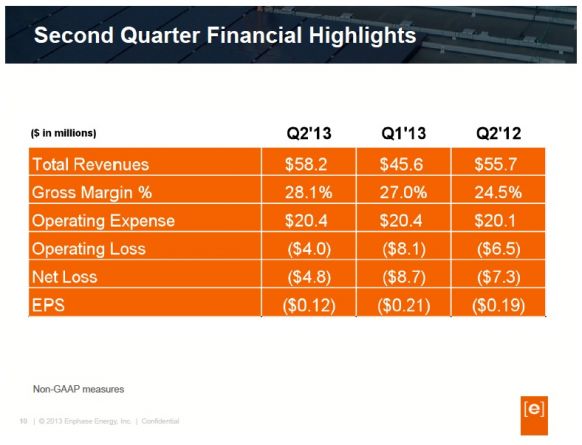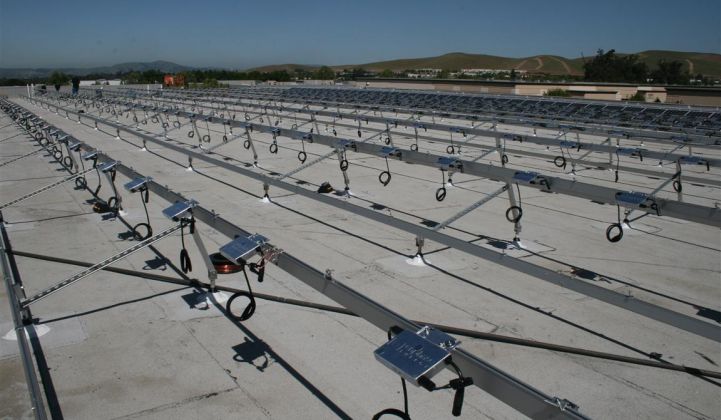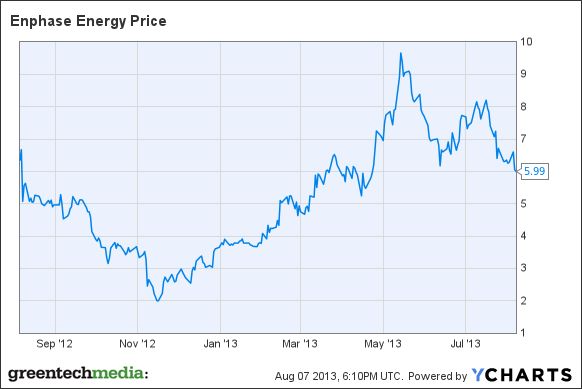While Enphase's recent earnings calls continue to show growth in revenue and margin, along with steady operating expenses and execution, the market sent Enphase stock dropping 11 percent in after-hours trading today, after the company announced its second-quarter results. (Here's a transcript.)
The firm's Q2 revenue of $58.2 million was slightly off consensus. Margin improved to 28 percent on the 399,000 units sold in the quarter. Enphase had a net loss of $6.4 million in the quarter and exited Q2 2013 with a total cash balance of $34 million.
The firm guided Q3 revenue to be within a range of $59 million to $63 million at a gross margin falling between 27 percent and 29 percent. That Q3 revenue number is off the consensus estimate, due to inventory in the channel and the succession of the next-generation product, according to the firm.
After years of maintaining a focus on the U.S., Enphase is seeing growth in the U.K. and France, with 20 percent of Q2 revenue coming from outside the U.S.

If Enphase hits the low end of its Q3 guidance, the firm will need a $54 million fourth quarter to best its 2012 revenues of $217 million. Fourth quarters tend to be strong quarters in solar.
At Intersolar last month, Paul Nahi, Enphase's CEO, announced that the firm had a 53.5 percent share in the U.S. residential market in 2012. Nahi said, "We dominate and designed this category."
Here's an incomplete list of competitors and aspirants in the microinverter sector:
- SMA is still the dominant inverter company in a volatile, consolidating $7 billion market. SMA "is now shipping the [SMA microinverter] to the U.S. market."
- SolarBridge is a microinverter maker in the business of AC modules, getting to market in partnership with module makers.
- ReneSola is delivering 10,000 units per month in the U.S. according to Brian Armentrout, the firm's marketing director.
- Enecsys VP Kevin Bushby claims Enecsys has 160,000 microinverters worldwide through distributors and in cooperation with module makers.
- Power-One, acquired by ABB, has a microinverter and is offering installers a $20 per unit rebate for its 250-watt and 300-watt units.
- Petra Solar has installed over 170,000 AC modules, according to Mary Grikas, VP at Petra.
- Altenergy Power Systems (APS) has shipped more than 100,000 microinverters, the majority to the Australian residential market, according to a spokesperson from the firm
- Chilicon Power has just started building microinverters for its first large design win of 170 kilowatts (680 modules) in Simi Valley, California, according to a release.
- SPARQ Systems is partnering with Solartec Mexico, a solar panel manufacturer, to deploy solar on 1,000 "small homes" with PV modules using SPARQ's microinverters.
- CyboEnergy builds a "mini-inverter" with per-module-MPPT for four modules.
- The firm iEnergy has been shipping into the U.S. market since late last year.
- Involar, LeadSolar, and Samil Power also build microinverters.
Within the greater module-level panel electronics (MLPE) market, Enphase, SolarEdge (SolarCity is a customer), and Tigo account for 93 percent of the market share, according to GTM Research's MJ Shiao.




